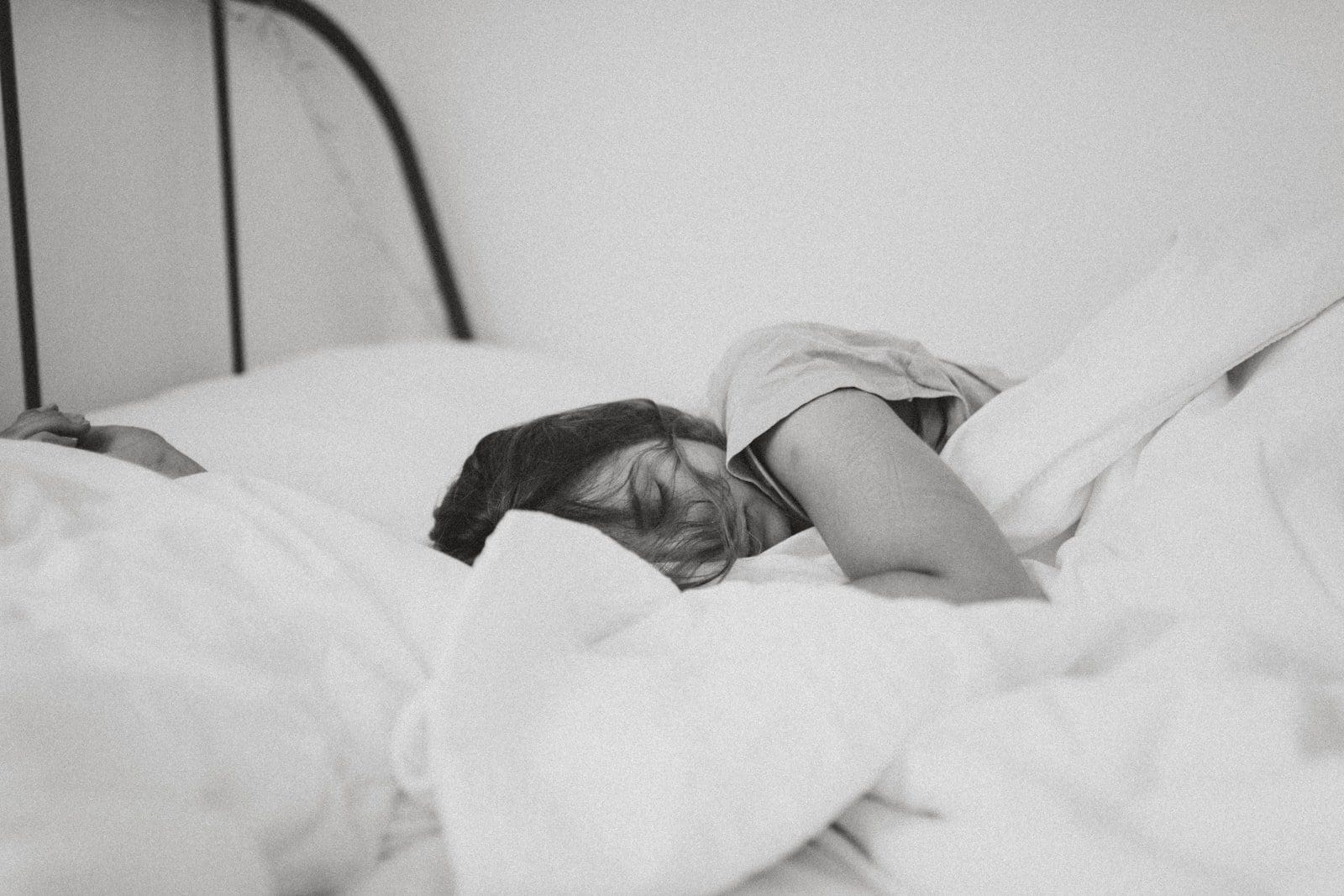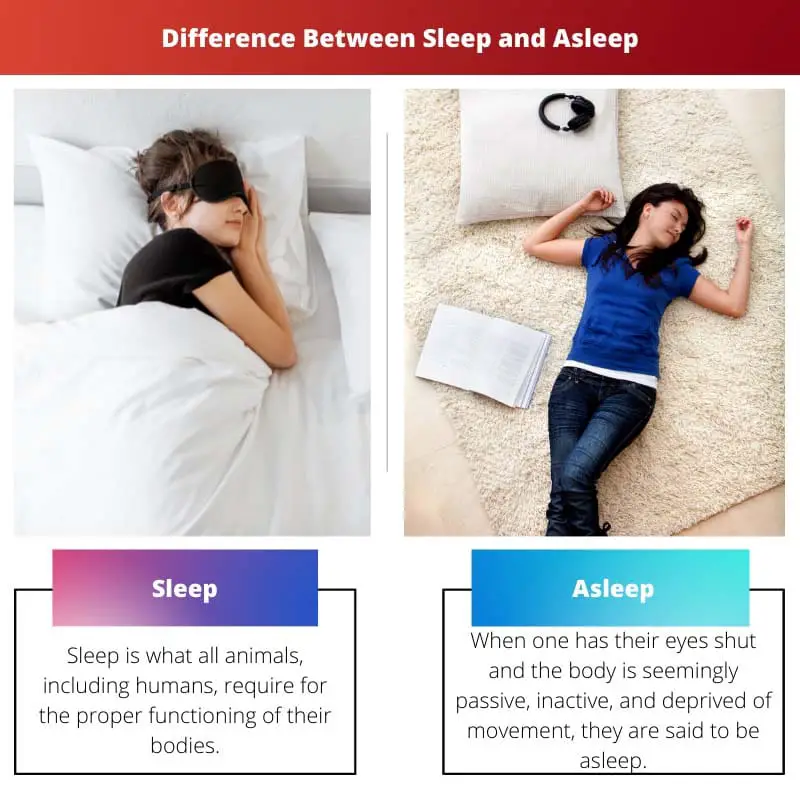The term sleep is a noun or, in most cases, a verb that refers to the act of wanting to go to sleep. The term asleep is a verb that refers to the act of already sleeping, i.e., in a state of sleep. Both the terms sleep and asleep revolve around different aspects of the front of sleeping or falling asleep.
Key Takeaways
- Sleep refers to a natural state of rest in which consciousness and voluntary movements are suspended, whereas asleep means sleep.
- You can fall asleep while sitting, but you cannot fall asleep while standing, whereas you can be asleep while lying, sitting, or standing.
- Sleep is a biological process necessary for physical and mental health, whereas asleep is a state of being resulting from falling asleep.
Sleep vs Asleep
The difference between sleep and asleep is that sleep is a noun or a verb, and asleep is an adverb or adjective. Scientists have been conducting experiments to find out what goes on while one is asleep. Similarly, the act of sleeping is mysterious and essential for the normal functioning of the human body.

Sleep could be considered a period when the body is inactive and the mind and body are relaxing. The nervous system regains energy during this period of inactivity.
The muscles are relaxed, there is no visible movement in the body, and the eyes are shut. The act of sleeping signifies that the body is incapable of any external movements.
Being asleep means somebody is already sleeping. Dreams seep through when one is asleep. Most people are not alert when they are asleep. The body is in a state of passive consciousness.
Asleep is necessarily the act when one is sleeping. It is not the act of going to sleep or getting up but, essentially, when one is sleeping.
Comparison Table
| Parameter of Comparison | Sleep | Asleep |
|---|---|---|
| Part of speech | Sleep can either be a noun or a verb. | Asleep can either be an adverb or an adjective. |
| Past tense | The past tense of the term sleep is slept. | The past participle of the term asleep is was asleep. |
| Representation | Sleep refers to the act of sleep, which is the state of inactivity. | Asleep refers to the condition of sleeping that is either continued or prolonged. |
| Significance | Sleep signifies the action of sleeping. | Asleep signifies the state of sleeping. |
| Sentence usage | Please take proper sleep, or you will be dizzy. | I thought you must be asleep. |
What is Sleep
Sleep is what all animals, including humans, require for the proper functioning of their bodies. While some species thrive on less sleep, humans, in particular, need six to eight hours of sleep regularly.
The neurotransmitters control the act of sleeping in the brain. Sleep may be easily disrupted or prolonged due to medicine, caffeinated drinks, pills, or supplements.
Usual habits may also affect sleeping habits. For instance, a smoker tends to have light and disrupted sleep. One important term associated with sleep is Circadian Rhythms.
These are characteristic changes that occur in your body during the course of the day. The biological clock of the body controls these rhythms. The reason why people feel sleepy and tired when it is dark is that the body stops producing melatonin, which is required to keep the body active.
The body’s clock controls melatonin production, body temperature, and any changes in blood pressure levels. Until recent discovery, people thought that their body clocks sync in 24 hours.
However, scientists recently found out that when light sources are taken away from the human body, the biological clock syncs every 25 hours. Due to the sunlight and artificial sources of light, your body coordinates from every 24 hours, one set at a time.

What is Asleep
Asleep refers to the act of sleeping. When one has their eyes shut, and the body is seemingly passive, inactive, and deprived of movement, they are said to be asleep.
Many people even say that death and asleep are only different due to one clause – a dead person does not wake up. There are certain stages when one is asleep. The most critical and mysterious part is called REM which is when one dreams.
Dreams are associated with the amount of your sleeping regime when you undergo the REM phase. REM starts about 90 minutes after you fall asleep. This is when your body shows changes.
Your brain begins activity by sending mixed-frequency signals to the brain. Your arms and legs become paralyzed, which prevents you from acting out of your dreams. Although most dreams come along during the REM stage of sleep, you can also dream in other stages while you are asleep.
These stages are non-REM and are called stages 1, 2, and 3. Stage 1 is your body’s way of converting from the state of being awake to the state of being asleep. Stage 2 is the period right before you enter deep sleep. Your muscles are relaxed and breathing controlled.
Stage 3 is deep sleep which could be considered the most essential. Stage 3 sleep is what you require to feel fresh in the morning. The reason why most of your dreams are either early when you are asleep or towards the morning is that the REM stage is concentrated to early and late hours.

Main Differences Between Sleep and Asleep
- The primary difference between sleep and asleep is that sleep is essentially a noun, while asleep is an adjective.
- While sleeping is a vital act required for proper functioning, being sound asleep (stage 3 sleep) is what imparts refreshment and energy.
- Sleeping is associated with deep unconsciousness, while being asleep also encompasses afternoon naps and the act of dozing off.
- Sleep is when the body is inactive and the muscles are relaxed, while asleep is the act of already sleeping.
- Sleep is an old English word derived from the word ‘slaep,’ while the word asleep is a derivative of the word sleep.

- https://academic.oup.com/sleep/article-abstract/5/3/267/2753293
- https://go.gale.com/ps/i.do?id=GALE%7CA88571372&sid=googleScholar&v=2.1&it=r&linkaccess=abs&issn=00123692&p=AONE&sw=w

Thank you for providing such an informative article about the differences between sleep and asleep. I appreciate the clear explanation of the different aspects of falling asleep and being asleep. It’s fascinating to learn about the biological processes behind sleep.
The comparison table is particularly helpful in distinguishing between sleep and asleep. It’s enlightening to learn about the differences in past tense and significance of these terms.
I couldn’t agree more. This article provides valuable insights into the scientific and physiological aspects of sleep. Understanding the differences between sleep and asleep is essential for maintaining healthy sleep habits.
The article effectively communicates the scientific and physiological differences between sleep and being asleep. The comprehensive approach to explaining the complexities of sleep enhances the overall understanding of this essential function.
I share your appreciation for the article’s comprehensive approach to explaining the nuances between sleep and being asleep. The scientific insights provided in this article offer a deeper understanding of sleep processes.
The comprehensive explanations about the biological processes associated with sleep and being asleep were particularly enlightening. This article presents complex concepts in a manner that is accessible to readers, which is commendable.
I couldn’t agree more. The article provides valuable insights into the scientific and physiological aspects of sleep and being asleep. The detailed explanations contribute to a deeper understanding of the intricacies of sleep.
The comparisons presented in the article contribute to a deeper understanding of the differences between sleep and asleep. The comprehensive explanations about various aspects of sleep provide valuable insights into this essential biological function.
I couldn’t agree more. The article effectively communicates the distinctions between sleep and being asleep. The comparisons and detailed explanations contribute to a richer understanding of the complexities of sleep.
The comparison table offers a succinct overview of the differences between sleep and asleep. It’s impressive how the article delves into the scientific and physiological aspects of sleep and being asleep.
I share your appreciation for the comparison table. It’s an excellent way to illustrate the distinctions between the verb ‘sleep’ and the adverb ‘asleep’ in a clear and concise manner.
I found the section on the body’s biological clock and melatonin production particularly intriguing. This article presents complex scientific concepts in an accessible way, which enhances understanding.
The insights into Circadian Rhythms and the body’s biological clock were particularly engaging. This article provides valuable information about the physiological processes that regulate sleep and wakefulness.
I completely agree. The detailed explanations about Circadian Rhythms contribute to a deeper understanding of the mechanisms that control our sleep patterns. The scientific insights in this article are commendable.
The details provided about the REM phase during sleep are fascinating. It’s interesting to learn how the brain and body function during different stages of sleep. This article is an excellent resource for understanding the complexities of sleep.
I couldn’t agree more. The section on the REM phase provides a comprehensive overview of the intricacies of sleep. The scientific explanations make this article a valuable resource for understanding sleep cycles.
The insights into the paralysis of arms and legs during the REM phase were eye-opening. This article offers valuable information about the physiological processes that occur during sleep.
The clarity provided in distinguishing between sleep and asleep is commendable. The article effectively communicates the biological and scientific aspects of sleep in an accessible manner, which enhances comprehension.
I completely agree. The detailed explanations about sleep and asleep are presented in a manner that promotes understanding. It’s evident that the article is well-researched and informative.
I found the comparison table especially helpful in understanding the nuances between sleep and asleep. This article serves as an excellent resource for anyone seeking to enhance their knowledge of sleep and its various aspects.
The detailed explanations about neurotransmitters and their role in sleep regulation were especially enlightening. This article offers valuable information for understanding the biological processes that govern sleep.
I found the explanations about neurotransmitters particularly illuminating. The article delves into complex scientific concepts in a manner that enhances comprehension, ensuring that readers gain a deeper understanding of sleep processes.
The section about Circadian Rhythms and how they affect sleep patterns is especially interesting. I appreciate the scientific explanations provided in this article, which help shed light on the importance of sleep for human health.
I completely agree. This article highlights the significance of sleep in a comprehensive manner. The details about neurotransmitters and circadian rhythms are enlightening.